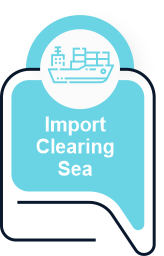Shipping Container Size Type
To meet your logistics needs, we as a company can provide you with helpful information regarding Shipping Container Size, Type & Capacity. Having been in the container logistics business for over 30 years, we are proud to say that we are experts in the field. Falcon is one of the most popular international container service providers operating in India.
Container Sizes, Dimension, Types, And Specifications
- ISO Shipping Containers have an exterior size (dimension) of 8’0″ (2.438m) wide by 8’6″ (2.591m) tall. The most commonly used lengths are 20ft (6.058m) & 40′ (12.192m). There are also “High Cube” containers, which are typically 40 feet long & are foot taller at 9’6″ (2.896m)
- Moreover, most of these containers are built-in types of 20ft or 40ft lengths, measured in Twenty-Foot Equivalent Units, TEUs. There are two types of containers: standard containers with an external height of 8’6″ and high cube containers with an exterior height of 9’6″.
- Furthermore, there are specific dimensions for shipping containers worldwide. According to the International Standard for Organization (ISO). Additionally, all containers must fit on container ships within millimeters of each other to stack without any problems.
What are the Shipping Containers?
In this paragraph, it is important to know what are the shipping containers. Generally, most people have heard of the large metal containers used to transport cargo by ship, train, or truck. These containers come in various sizes, but the most common size is a 20ft container. The 20ft container size is 20 feet long, 8 feet wide, and 8 feet tall. Shipping containers can store and transport all sorts of things, from food and clothing to cars and construction materials, etc.
There are multiple benefits to using shipping containers. They are strong and durable, so they can withstand being shipped worldwide and loaded and unloaded by crane. They are also weatherproof to protect your belongings from the elements. Shipping containers can be stacked (placed) on top of each other to make the most of your available space.
A shipping container could be the perfect solution if you’re looking for a cost-effective. Know more about the 20ft container size and all details via call at +91-9311595648 or email at cargodeal@falconfreight.com.

Shipping Cargo Container Size List
In this paragraph, If you are looking for detailed information on the Shipping Cargo Container Size List.
To ensure no problems during shipment, ocean cargo containers are held to a strict standard. The intermodal shipping containers (sometimes referred to as “conex” containers) must be able to not only stack perfectly aboard a cargo ship but also lock into chassis trailers and stack securely on rail cars. Specifically, ISO 668 is the standard for shipping container dimensions set by the International Organization for Standardization (ISO). You will find six different types of containers.
Note: Dimensions may vary slightly depending on the manufacturer. Nevertheless, these numbers should be very close.
Six Types of Containers Listed Below:
- Dry storage containers are the standard previously mentioned shipping containers used to ship dry materials in lengths of 10ft, 20ft, and 40ft.
- A flat rack container has collapsible sides that can be folded, making them ideal for shipping boats, equipment, and cars.
- Containers with open sides here, you can open the doors on the side, making it easier to load materials, such as vegetables.
- Open-top containers – These don’t have a roof so they can carry anything with a height, such as logs or machinery unsized cargo, etc.
- Refrigerated containers are commonly used, such as food and pharmaceuticals, frozen food, etc.
- Tanks – are used to hold liquids (including fuels)
20 Feet Shipping Container External Internal Dimensions Size, Type & Capacity
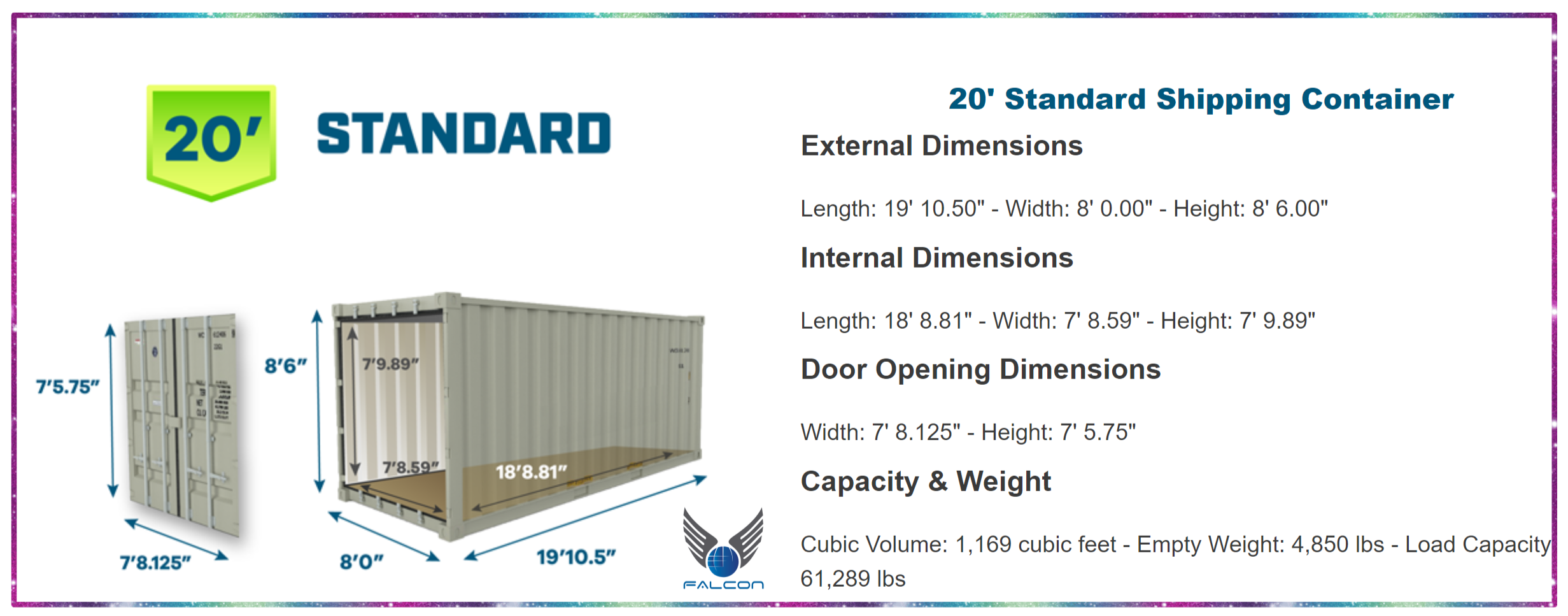
40 Feet Standard Shipping Container External Internal Dimensions Size, Type & Capacity
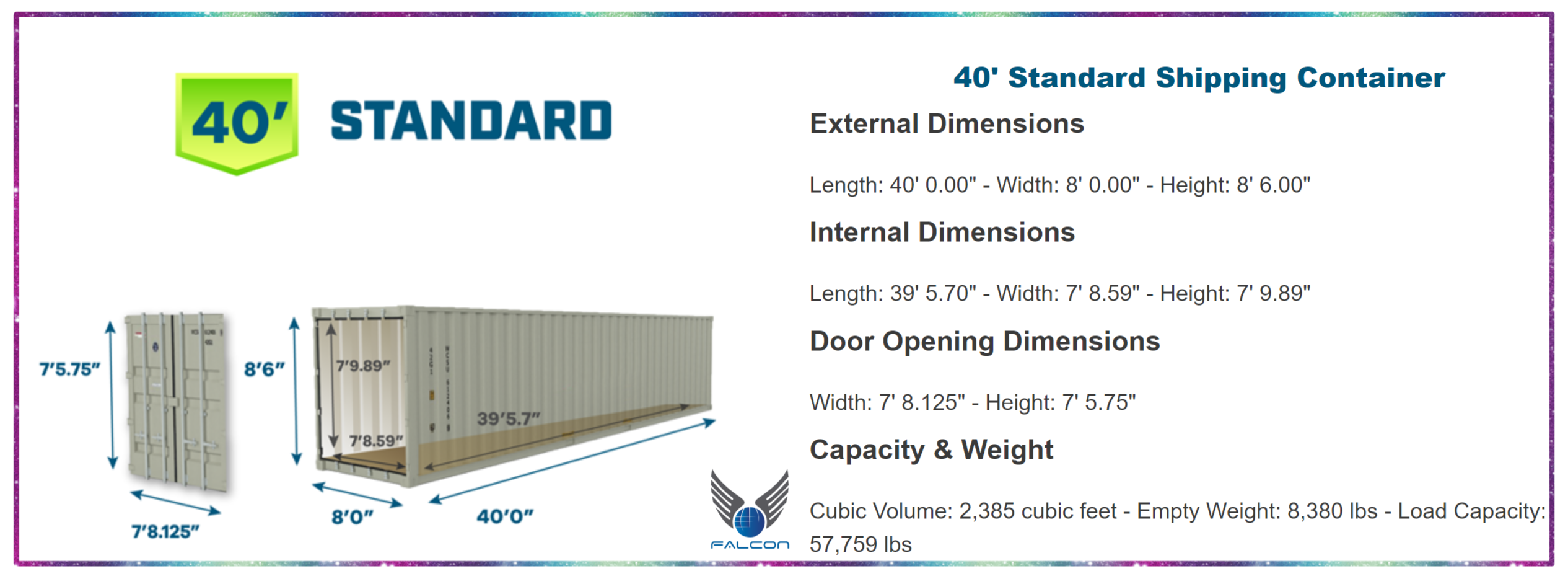
40 Feet High Cube Shipping Container External Internal Dimensions Size, Type & Capacity

45 Feet High Cube Shipping Container External Internal Dimensions Size, Type & Capacity
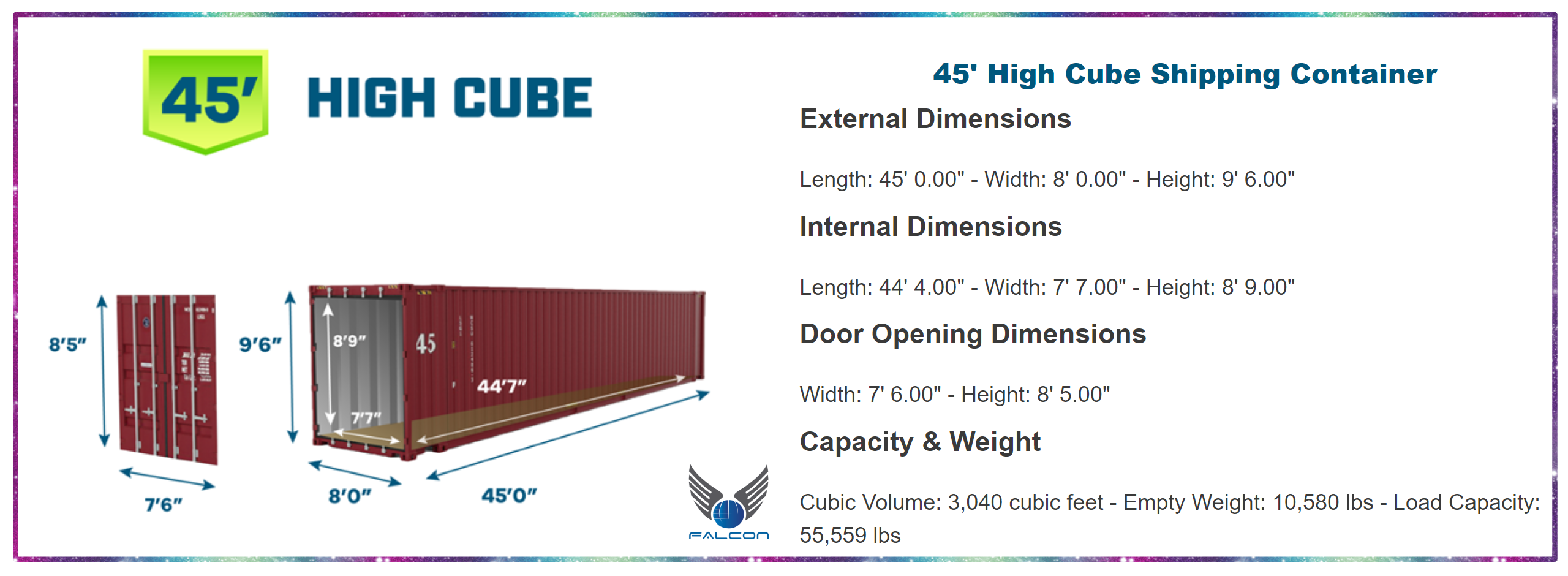
10 Feet Shipping Container External Internal Dimensions Size, Type & Capacity
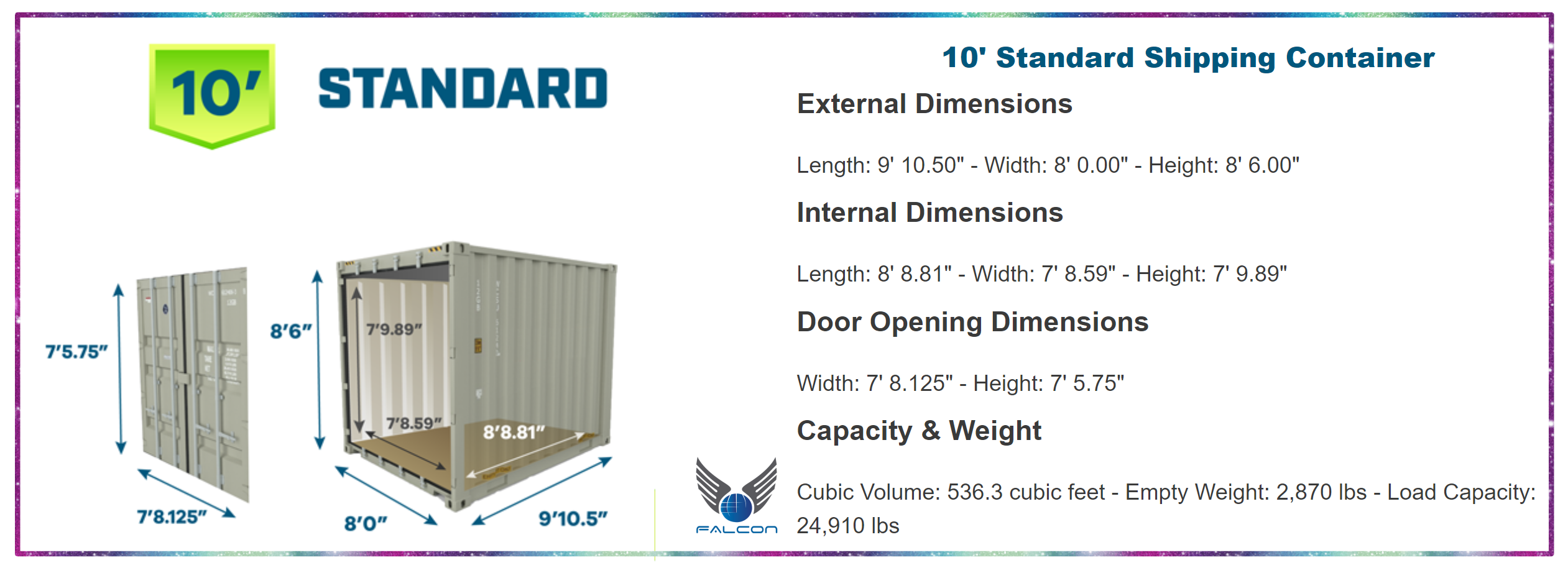
We are happy to assist you in freight booking of the container, custom clearing, and if you want to have information regarding Container Size For Logistics in India. Then, please don’t hesitate to get in touch with us at +91-9311595648, cargodeal@falconfreight.com
Learn about the history of the shipping containers.
Before 1950 Shipping History
In this paragraph, learn about the history of shipping containers. Most importantly, loading a cargo ship was a time-consuming task in which cargo was loaded piece by piece onto a vessel. So, to expedite the transport of supplies during the Korean War, the US military developed “Container Express” boxes. Throughout history, the term “Conex” has been used to describe shipping containers. Thus, before the 1950s, there were also many different container systems, but each shipping container was still very different from company to company and not interchangeable.
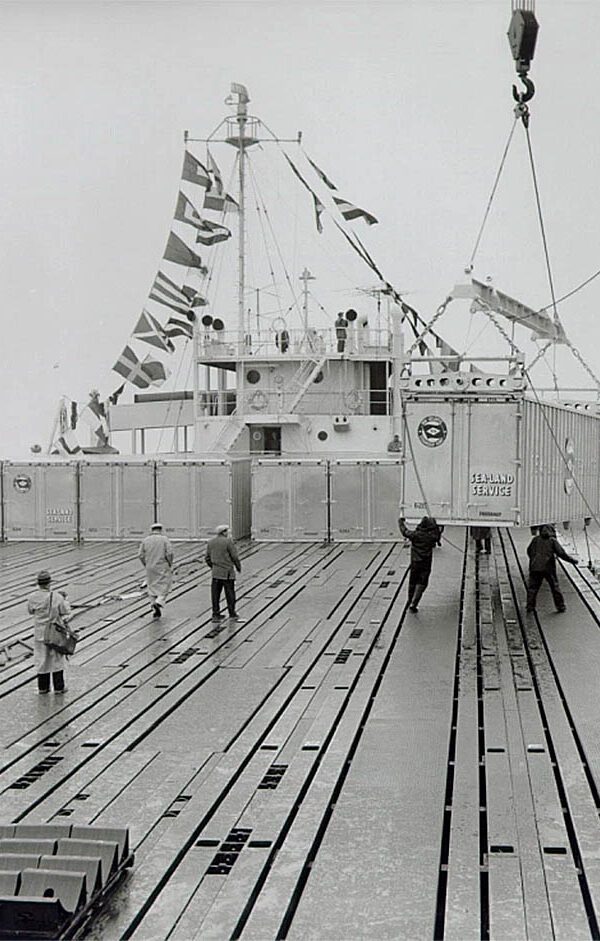
Commercialize Container Shipping
Malcolm McLean is often credited with “inventing” the shipping container, but that’s a bit of a stretch. McLean was undoubtedly the first to commercialize container shipping successfully but definitely was not the first to develop the idea. For example, the Bureau International des Containers (BIC) was founded in 1933, 23 years before McLean would transport a few dozen containers from Newark to Houston on a repurposed World War II cargo ship in 1956. Two years later, Matson began offering containerized freight services.
Shipping Containers of Standard Dimensions
Now held by Maersk, Malcolm McLean’s original container freight company had 33′ and 35′ shipping containers. Matson’s shipping containers were 24′ long. In late 1960. Moreover, the International Organization for Standardization (commonly referred to as ISO) established standards for shipping container dimensions via ISO 668. According to ISO standards, containers are now measured in TEUs (twenty-foot equivalent units). Today there are over 34,000,000 TEUs in circulation (or roughly 20,000,000 containers).
History of the Shipping Container in Detail
The history of the shipping container is a fascinating one. These massive containers have revolutionized how goods are transported worldwide, and their story is interesting.
The first shipping containers were used in the early 1800s, but they were not the large steel containers we are familiar with today. Instead, they were made of wood and were only used to transport relatively small items. In 1956, the first large steel shipping container was developed. This new type of container was much more durable and could carry much larger loads.
Shipping containers quickly became popular and began to be used worldwide to transport all sorts of goods. Today, millions of shipping containers are in use, and they play a vital role in the global economy.
It’s hard to believe that the humble shipping container has only been around since the 1950s. Invented by an American trucking magnate named Malcolm McLean, containers revolutionized how freight is moved worldwide. Today, almost all international cargo is transported in containers, thanks to McLean’s vision.
Idea of Using Containers for Shipping
Interestingly, McLean didn’t invent the idea of using containers for shipping; that credit goes to a man named Keith Tantlinger. Tantlinger was an engineer who worked for McLean, and he came up with the idea of using containers to make shipping more efficient. However, McLean saw the potential in Tantlinger’s view and ran with it.
McLean’s company, Sealand, was the first to start using containers for shipping, and it wasn’t long before other companies followed suit. The benefits of using containers were immediately apparent; not only could more goods be shipped at once, but loading and unloading times were significantly reduced. Containers also made it possible to ship fragile items without fear of being damaged in transit. Briefly, the shipping container history in the logistics industry has been quite a lengthy one.
What Benefits of Using Container for Shipping
To know more about, what benefits of using containers for shipping worldwide
- Shipping containers can save shipping costs and reduce pollution.
- Allow for a more efficient storage, transport, and distribution system of goods.
- Help lower prices by increasing competition.
- Increasingly being used to ship goods internationally, which has led to a rise in global trade.
- Shipping containers have brought about many benefits for the global economy.
- Offer a more efficient way of transporting goods worldwide.
- A significant part of the global shipping industry’s supply chain.
- The global container shipping industry supports 25 million jobs worldwide.
- Created frictionless trading by providing low-cost, standardized solutions for traders and customers with different needs.
- Used in the global trade of goods, a significant source of wealth for countries.
You are answering your question above; What Benefits of Using a Container for Shipping?
Know More About Freight Containers
If you’re new to shipping containers, you might be wondering what all the fuss is about; then, you should know more about freight containers. Freight containers come in various sizes, and each has its benefits and drawbacks. In this blog post, we’ll take a closer look at some of the most popular container sizes to decide which one is the right one for your needs.
20-foot containers are the most common type of container used for international shipping. They’re also the smallest size that is suitable for ocean freight. 20-foot containers have a capacity of 1,360 cubic feet (38.5 cubic meters), which is equivalent to about 10 standard pallets.
40-foot containers are the next size up from 20-footers, and they’re the most popular choice for shipping large volumes of goods. The 40-foot containers have a capacity of 2,700 cubic feet (76 cubic meters), which is enough space for about 20 standard pallets.
45-foot containers are another option for shippers who need a little extra space. These containers are 9 feet longer than 40-footers, and they have a capacity of 3,040 cubic feet (85 cubic meters). That’s
Container types For Which Products are Suitable For
we all know that freight containers come in different shapes and sizes, but what do these numbers and letters mean? Let’s look at the most common container types to see what they’re suitable for.
– A 20-foot container is the most popular size for general cargo. Household goods, electronics, and other consumer goods commonly use it.
– Typically, companies use a 40-foot container for heavier cargo, such as machinery or building materials.
– The most extended standard size for containers is 45 feet, and companies mainly use it for oversized or heavy cargo that doesn’t fit in a 40-foot container.
So, now you know more about freight containers and their various sizes. If you have any questions, ask Falcon 18 for more information; please contact: +91-9311595648 or email us: at cargodeal@falconfreight.com.
MORE FROM OUR SERVICES
PROFILE INFORMATION
Year of Establishment : 1996
Business Type: Import-Export Trade Consultant
Estimated Yr Sales (USD): 2 – 5 M
Number of Employees : 80-100
mail at: cargodeal@falconfreight.com
Call us at : +91 9311595648
OFFICE ADDRESS
219, Admin. Building, Inland Container Depot, Tughlakabad
New Delhi 44, India.
Branches/Services providing areas: : Delhi, Mundra, Mumbai, Chennai, Kolkata, Hazira, Ludhiana, Delhi Airport, Panipat – Click for more
